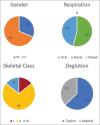Cranio-cervical posture and rapid palatal expansion therapy
- PMID: 35754428
- PMCID: PMC9214420
- DOI: 10.4103/jos.jos_128_21
Cranio-cervical posture and rapid palatal expansion therapy
Abstract
Objective: Connections between craniocervical posture (CCP) and changes in teeth position have already been demonstrated; however, the defined pathway of relationship is still not clear. The aim of this study was to evaluate CCP modifications after rapid maxillary expansion therapy using rapid palatal expansion therapy (REP)/McNamara appliances.
Materials and methods: A consecutive series of 35 subjects, aged between 6 and 14 years, with no prior history of orthodontic treatment, and requiring skeletal expansion of the upper arch, were selected and analyzed. All patients were treated with REP or Mcnamara appliance: the active phase of 15 days and retaining phase of 6 months. Cephalometric analysis was carried out before (T0) and after (T1) orthodontic therapy evaluating changes in the craniofacial area and those related to CCP. The obtained data were statistically analyzed for the pre-post changes.
Results: No statistically significant difference emerged indicating a modification in the CCP measured at T0 and T1 (P > 0.05). Patients treated with the McNamara appliance, compared to those treated with REP, showed a higher value of the angle OPT ^ Ver (P = 0.021), and a lower measure of the angles CVT^EVT (P = 0.035) and EVT^Ver (P = 0.023). Furthermore, patients treated with REP showed a higher hyoid angle value than those treated with McNamara (P = 0.047).
Conclusion: This study did not reveal any relationship between the application of palatal expansion therapy and changes in CCP.
Keywords: Craniocervical posture; malocclusion; orthodontic therapy; rapid palatal expansion.
Copyright: © 2022 Journal of Orthodontic Science.
Conflict of interest statement
There are no conflicts of interest.
Figures
References
-
- Akcam MO, Koklu A. Investigation of natural head posture in different head types. J Oral Sci. 2004;46:15–8. - PubMed
-
- Romani V, Di Giorgio R, Castellano M, Barbato E, Galluccio G. Prevalence of craniomandibular disorders in orthodontic pediatric population and possible interactions with anxiety and stress. Eur J Paediatr Dent. 2018;19:317–23. - PubMed
-
- Arntsen T, Sonnesen L. Cervical vertebral column morphology related to craniofacial morphology and head posture in preorthodontic children with Class II malocclusion and horizontal maxillary overjet. Am J Orthod Dentofacial Orthop. 2011;140:e1–7. - PubMed
-
- Castellano M, Lilli C, Barbato E, Santilli V, Galluccio G. Craniofacial asymmetry in non-syndromic orthodontic subjects: Clinical and postural evaluation. Cranio. 2016;34:144–54. - PubMed
-
- Westersund CD, Scholten J, Turner RJ. Relationship between craniocervical orientation and center of force of occlusion in adults. Cranio. 2017;35:283–9. - PubMed
LinkOut - more resources
Full Text Sources


